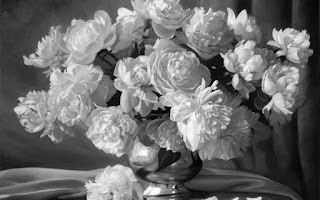'Still Life - White Peonies'
[Click image for larger version. Apologies in advance for the tag on the upper right.]
Zbigniew Kopania Henry'Still Life - White Peonies' (exact title unknown, c. late 20th century)
Oil on canvas (dimensions unknown)
~ ○ ○ ○ ~
Since I accidentally already started with all those animal paintings, am going to begin a leisurely overview of the 'traditional' painting genres this week, including some of the new and/or spinoff genres that exist these days. Each genre will get about one week, but I may or may not do them consecutively.
So for the record, those traditional genres (in *descending* order of importance) are as follows in the classical hierarchy:
- History painting (which includes religious, mythological, and other sorts of didactic narrative)
- Portrait painting
- Genre painting, or scenes of everyday life
- Landscape (including cityscape, skyscape, etc.)
- Animal painting
- Still life
And where does this random ranking come from? Initially from Italian traditions after the High Renaissance (starting ~the 1500s), ultimately given its most definitive incarnation in the French Academy, lasting in pretty pure dictatorial form all the way through to the 1800s. The idea of a genre hierarchy sounds snobbish, and it is1, but the idea behind it is pretty simple: give most importance to works trying to use hard intellectual work to show us something universal or transcendent (the 'invisible' realities behind the stuff we see), and least weight to pictures that 'mechanically copy nature'. Things have changed a lot, but people still often tend towards those impulses today — this picture "says something", but that picture "just looks like a photo"2.
So we'll get this show on the road at the bottom of the pile, with still life. Whatever working definition you've got in your mind is probably fine, but for the sake of exactness:
Still life: a work with an arrangement of inanimate objects (typically common objects) as the subject. The work can be used to illustrate a 'slice of life', may serve a simple decorative function, or may have greater artistic/symbolic significance.
Common historical subcategories: 1) Flower arrangements, 2) Food spreads, 3) Dead animals, with or without some connection to food spreads3, 4) Symbolic arrangements (such as 'vanitas' paintings4), and 5) Artistic statement pieces.
By the by, I suck at still life. Can't seem to make sense of it as something by itself, which probably speaks to a deep inadequacy of composition abilities that I am in fact trying to fix. However, I can/do enjoy and 'get' it when other people do it, so going to run with that for now.
Above is a piece by Zbigniew Kopania Henry, and I'm afraid that's about all I know about the artist. Except that he's also Polish, was born in the mid-twentieth century, and is apparently still working?
On the one hand, you could look at the work above and see how this could be looked down upon as 'mere mechanical copying'. There is cloth draped over a table, there is a bowl of flowers smack in the middle of the frame. All the stuff looks like the stuff it is supposed to look like, with nothing there that couldn't exist in real life.
On the other hand, the things that I like about this artistically:
- The colors. Which have a slightly-unreal creaminess and luster, and which you can damn near hear harmonizing here, also not something that occurs by itself in nature.
- The arrangement. It's pretty boring at the table level, but the little windows into dark stems are spaced nicely, and the weight of the actual flower heads swings you around the picture pretty well.
- The values. As is often the case with flower still life in particular, the values are far more nuanced, varied, and orchestrated than first impression might suggest. Easiest to see in grayscale:
BAM.
Still life is a funny little hobgoblin of a genre, and we'll get into why with more examples throughout the week. For now, we can just remember that it's probably the most popular genre as far as the actual public goes (buyers, collectors, lovers and appreciators of art at all levels), and if you looked at that picture up there and immediately thought "That's pretty", that would be why.
FOOTNOTES:
FOOTNOTES:
1. The sorts of petty, petty bullshit that came out of the Academy is staggering, and hilarious. I want to get my sources/stories straight before I share anything specific, but the Academy is going to get mocked on this blog about 70% of the time and I just wanted you to know why.
2. Not to be confused with pictures that "look just like a photo!" Contemporary reactions to photorealism will be getting their own rant fairly soon, and probably several times over.
3. If you've got questions about that, so do I. We'll blame the Dutch.
4. Vanitas paintings = those paintings with little skulls and watches and burnt-out candles that are all "Hey, everything you care about is going to rot and we're all going to die someday, so enjoy your earthly delights and hope you've found god you horrible meatsack". Massively popular theme in art, literature, what-have-you, so will be returning to it multiple times, but example later this week.
3. If you've got questions about that, so do I. We'll blame the Dutch.
4. Vanitas paintings = those paintings with little skulls and watches and burnt-out candles that are all "Hey, everything you care about is going to rot and we're all going to die someday, so enjoy your earthly delights and hope you've found god you horrible meatsack". Massively popular theme in art, literature, what-have-you, so will be returning to it multiple times, but example later this week.

